World Cup 2014 Round-Up: 8 Social Video Facts Every Marketer Should Know
Suarez being banned for biting another player, hosts Brazil being hammered by Germany 7-1 and former champs Spain falling at the first hurdle – it’s certainly been a World Cup to remember.
But as Germany return home as heroes, it’s worth remembering that the men in shin pads and boots were not the only star players battling it out over the last month. Brands and their agencies have also been in the thick of the action.
The World Cup was not only the prime marketing event of the year, it was arguably the biggest marketing event of all time, attracting millions in sponsorship and merchandising rights.
Whether they were affiliated with FIFA or not, the World Cup offered brands the chance to engage billions of people entranced by what was happening on the pitches of Brazil. According to Twitter, the 2014 World Cup is the most tweeted event of all time.
But which brands triumphed? What kind of content attracted the most shares? Were there any themes? And what were the sharing patterns? Well, here are 8 facts we have managed to pull out. Enjoy!
1. Seven out of 10 shares were for ads not affiliated with the World Cup
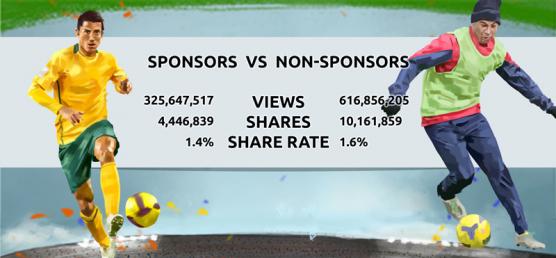
If you look through the most shared ads of the 2014 World Cup, almost three-quarters (69.6%) of the shares came from brands not affiliated with the tournament.
Despite creating almost twice as many videos (143 v 267), none of the top three most shared brands (Danone, Nike and Samsung) are FIFA partners. But why did non-sponsors prosper? Well, our suggestions are:
- Non-sponsors have creative freedom, unconstrained by endless regulations and laborious approval processes that often result in creative being reduced to a shadow of its former self. Merchandising and licensing drives brand awareness but this limits the opportunity to activate beyond their sponsorship rights;
- With allegations of corruption and match-fixing, FIFA is also not exactly a brand you would like to be associated with right now. Sponsors have to not only manage their image at the event, but also their association with rights holder;
- The internet has changed the rules, giving non-sponsors a bigger platform to generate mass awareness around the World Cup.
But which brands performed the best? Well, Activia takes the number one spot thanks solely to its musical collaboration with Colombian pop star Shakira, “La La La”. The Danone yoghurt brand has held pole position since the start of the tournament and with 4.7 million shares since its launch, it is well ahead of the pack (Nike, another non-sponsor, is second with 2.6 million).
Another non-sponsor, Samsung, takes third spot after the tech giant’s ads attracted 1.28 million shares, while Beats By Dre, which was recently purchased by Apple, and Japanese noodle company, The Nissin Group, also makes it onto the top 10. To see the full rankings click on our Braziliant Brands Tracker.
It’s something marketers who can’t afford to fork out millions on 30 seconds of Super Bowl airtime should take note of.
Old Spice and Newcastle Brown Ale are brands who have previously generated a lot of attention despite their ads not being part of Super Bowl Sunday. Can we expect more next year?
2. Most video ad shares occurred in the hours leading up to kick-off
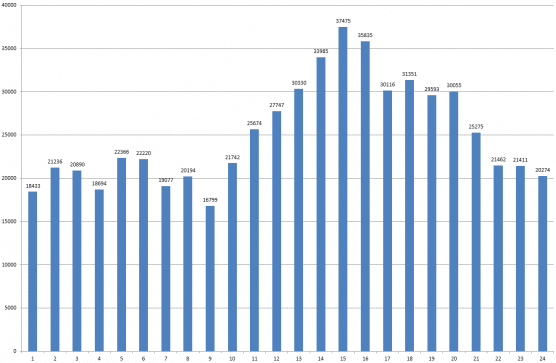
The 2014 World Cup may well have been the biggest branded video sharing event of all time, but it looks like most of the sharing was done just before the games kicked off*.
Looking at sharing patterns around the most popular World Cup ads, we noticed that sharing peaked at around 3-4.59pm BST, prior to a lot of the early kick-offs in the tournament. The biggest spike was between 3-3.59pm.
During the games themselves, sharing tended to drop off. It suggests that people were simply too engrossed in the matches to pick up their phones, tablets and laptops and share. This is similar to the Super Bowl, where sharing flattens on the day itself, but then rises again the day after.
* Based on sharing numbers of sample of five World Cup ads.
3. The most shared ad from an official FIFA partner was from Castrol
Getting the biggest name in the Brazil football team and the star of the most successful social video advertising franchises of all time to front its campaign was a masterstroke by Castrol.
“Footkhana”, which saw Brazilian striker Neymar face off with driving sensation and Gymkhana legend Ken Block, attracted 1.03 million shares across the social web, making it the third most shared commercial overall and the most successful ad from a FIFA partner.
To see the top 20 most shared ads, click here.
4. Almost half of the most shared ads of the year so far are World Cup-related
Almost half of the top 10 most shared ads of 2014 so far are World Cup-related. We’re just halfway through 2014, but it’s already looking like a World Cup year for social video marketing, with four of the top 10 commercials coming from FIFA sponsors or brands looking to take advantage of the world’s biggest soccer tournament.
Dubbed by many as the unofficial World Cup theme song, “La La La (Brazil 2014)”, is so far leading the battle for this year’s social video crown. It’s also the fourth most shared ad of all time.
Why was it successful? Because it’s a good example of a trackvert – a video that blurs the lines between traditional advertising and music videos. Why is this important? Because music videos are by far the most shared videos online. In fact, 99% of the top 100 are music videos.
Their sharing patterns are also different to normal adverts. Normal ads generate the majority of their shares in the first week (around 65%) then suffer significant viral decay. However, music videos have more longevity. It means that Activia is on course to have the most shared ad of the year.
Two Nike ads, “Winner Stays” and “The Last Game”, also make it on to the top 10, while official sponsor Castrol is eighth.
Meanwhile, only one ad from this year’s Super Bowl makes it on to the list – Budweiser’s “Puppy Love” ad. It’s further evidence that Super Bowl sponsors need to raise their game next year.
5. The World Cup is a lot bigger than the Super Bowl
World Cup ads attracted almost three times more online shares and views than the Super Bowl 2014 commercials managed.
Looking at the top 40 most shared ads from each (below), you can see that the World Cup accounts for 71.7% and 72.2% of the total number of shares and views respectively.
It’s yet further evidence that this year’s Super Bowl was more than a little lacklustre. Despite an overall rise in shares of branded videos (by 22%), this year’s game was the first time in the sporting event’s history that shares of online ads went down – 29% from 2013.
In fact, the World Cup had managed to overtake the Super Bowl before a ball had even been kicked. According to data compiled two days before the tournament kicked off, the 20 most shared attracted 6.9 million shares, almost a third (31.4%) more than the 20 most shared Super Bowl 2014 ads managed months after Super Bowl Sunday.
6. Nike beat adidas (again)
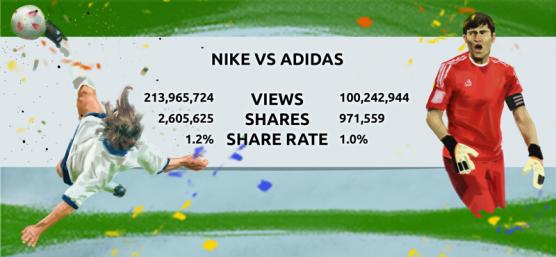
One of the key brand battles everyone is talking about, of course, is Nike v adidas. It’s a fight where adidas usually comes out second best, despite being a sponsor since 1970.
This year’s World Cup was no different, with Nike claiming almost three-quarters of the total number of ad shares between the two and more than twice as many views – despite creating fewer videos.
That’s not to say that Nike had it all its own way. Both teams in the final were adidas teams, adidas players had better tournaments, while the German company’s focus on real-time marketing paid off, as it generated more mentions on Twitter throughout the tournament. But when it comes to creating ads that people share and like, Nike are still the champs.
7. Video ad shares peaked on the first day of the World Cup
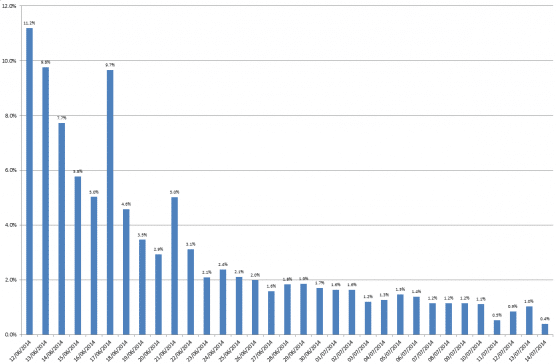
Anticipation in the hours leading up to the opening match between Brazil and Croatia meant that video ad shares on the opening day were the highest of the entire tournament.
In fact, 65% of the video shares generated by the sample of ads* we selected occurred in the first week-and-a-half, as interest waned during the tournament. This follows Unruly’s Social Diffusion Curve, which shows that the top video ads generally attract the vast majority of their shares in the first week and then experience a severe viral decay in the week that follow.
Other sharing spikes occurred on June 13, the day after the tournament began, and June 17.
* Based on sharing numbers of sample of five World Cup ads.
8. Sponsor Coca-Cola generated more fizz than Pepsi
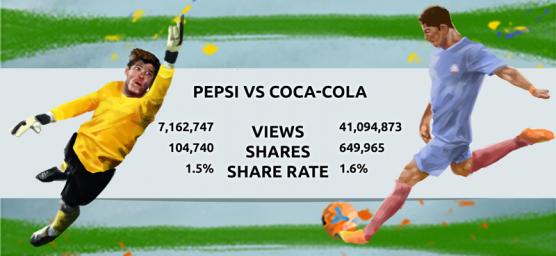
However, not every sponsor went home from Brazil with their tails between their legs. FIFA partner Coca-Cola’s ads attracted a lot more attention than rival Pepsi, generating a staggering 86.1% of the total number of shares between the two.
Coke also ran the most successful social media campaign, according to Social Bakers.
